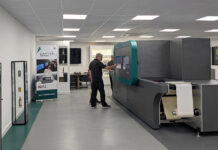PROMOTIONAL FEATURE
Minebea Intec recently announced that it was adding a ‘fourth pillar’ of quality inspection for customers with the manufacturer’s new series of vision systems. The automated VisioCompact®, SmartInspector® and VisioPointer® machines are the latest innovations designed to improve production line inspection and bring a range of quality and efficiency gains. Here, Minebea Intec project specialist Derek Maher and new business manager Mark Clifford explain more.
Q) How have vision systems evolved over the years?
Derek: Traditionally, when vision first appeared on the scene, it was for label verification and later on, seal integrity. More recently, it’s been adapted to inspect products more deeply, looking at them before the packaging, checking the content of actual food. For example, in pizzas it’s used to look at the dispersion of toppings; likewise for quiches to identify the type of quiches and ensure they’re being married up to the right packaging.
The abilities of vision have vastly improved. Bread can be checked to ensure it has been baked properly using colour and the physical sizes of items like baguettes can be checked to see that they’re the right depth and length. The capabilities have widened hugely in recent years, which is why vision systems are being used more in the food industry as a standard machine at end of line inspection to ensure quality.
Q) What are the latest Minebea Intec innovations in this field and what’s next on the agenda?
Derek: We have the entry level VisioCompact®, which provides label verification. It will check that a label is the right label and check the date, the barcode, artwork, and verify that all the information is correct for that product.
Mark: The VisioCompact® is able to fit neatly above an existing production line. If you want an entry level label verification system, it’s a really good price based on its capabilities and the intuitive Human-Machine Interface (HMI). For a top label check, you just mount it over an existing conveyor you’ve already got. It includes all the software, the camera and a cabinet in order to control the environment and keep the optimum lighting conditions to produce consistent images. It’s a complete vision inspection system in a nice, reasonably priced unit. And it’s compact, hence the name.
Derek: From there we have the VisioPointer®, which is the three-camera system featuring top and base camera in a cabinet with a conveyor, with an option for a third camera which is backlit with an infrared light looking at seal inspection.
Mark: If a customer comes to us wanting to do product inspection, like check for blood spots or bruising on salmon, as a pre-end of line check, we’ve got that capability. The system is not just top, base and seal inspection; we can do so much more including bespoke applications.
Derek: For example, we’re currently looking at cameras above existing filling lines to detect defects within plastic pots. We’re also working on confirming the presence of sauce sachets inside a pre-filled pot as well as ensuring they’re the right colour and therefore the right flavour. Another application is looking at big cheese wheels, to detect blue plastic that has been caught inside the cheese when it’s been unpacked.
All of these were initially manually inspected. What’s driving the automation of this is the capabilities and accuracy, combined with the financial saving of taking labour off the line, especially given the current labour shortages in the marketplace.
Q) How has Minebea Intec responded to increased demand for automation?
Derek: As well as vision, we also have an automatic labeller (the WPL-A) within our portfolio. What’s driving automation in the industry are labour shortages, labour costs and the need for greater quality control. The gap between what it costs to put a person on the line and the cost of the equipment has reduced. So, it’s become more cost effective to invest in automation.
Mark: Traditionally, SMEs wouldn’t have invested in this type of technology; they would have just employed another operative. They’re now finding themselves in a situation where they can invest in technology to carry out essential quality checks.
Q) Have customer requirements changed over the years in terms of what they expect out of vision systems?
Derek: When products have stayed the same, the requirements for vision have stayed the same. As different products, different packaging systems, and innovations in packaging emerge, you have to change the inspection criteria to support it. With new products coming online, we’re having to find different ways of continually quality checking them. Hyperspectral cameras fall into that, which use the reflection of light waves to detect defects such as different bruising on apples.
Mark: Traditionally, it was something that the eye could see. If you can see it, we can see it with a camera. The industry is pushing further now; for instance we have been asked to see bruising in apples, something that can’t be seen or would be easily missed by an operator. Hyperspectral is the next step and we are rolling it out now.
Q) What is the fourth pillar of quality inspection?
Mark: What we’re trying to do with the product range is make things easier. With both the labelling systems that we’ve introduced and the vision systems, these have traditionally been very difficult products to set up on the factory floor. What we’re seeing in the Minebea Intec portfolio is ease of use. It really is about bringing the expertise level down to the shop floor so they can carry out changes more easily, whether that be information printed on a label or tare weights, all the way to vision and seal check setups.
We are making it less complicated to make those adjustments, and at the same time providing full audit trails to record any adjustments that are made. The percentage tolerance on a defect, for example, could be changed by the operator or line supervisor; it no longer needs to be a QA or engineer-level responsibility.
Derek: We have made the HMI much more intuitive. From a usability perspective, it is child’s play for a supervisor to make those changes. That’s been the biggest fear of industry – the complexity of the equipment.
Mark: From a customer’s perspective, there’s a cost benefit. In these industries you tend to have some staff turnover. If things are complicated, staff require an extensive training course. The easier we make the HMI, the easier it is for our customers to train internally. This way you haven’t got a machine standing waiting for somebody to be trained and you don’t have the cost of re-training the new staff by the manufacturer.
Q) What common issues will the latest vision systems help to eliminate?
Mark: Labour shortages and inaccuracies caused by manual processes.
Derek: A big part of that as well is customer confidence. Certainly, with the major retailers they demand a certain level of quality assurance in their stores. If they see another tier, it gives them confidence that the products are going to be thoroughly checked and tick the boxes they’re looking to be ticked.
Mark: We all know the high cost when dealing with the large retailers if something is wrong and it gets to the store. There can be initial fines, and if there’s a product recall there is a cost for the shipping back to the supplier, and then a cost to dispose of that product. It can be quite catastrophic when this happens both financially and commercially. That might just be a badly printed barcode or it might be a substantial issue with the product seal reducing its shelf-life.
Q) What can we expect to see from Minebea Intec at the upcoming Foodex show?
Mark: We’re showcasing labelling solutions – both manual and automatic – as well as the vision systems. On this particular occasion, we will be exhibiting our latest labelling system. This will be the first time that this particular machine has been shown in the UK. We also have our core products such as scales and checkweighers, metal detection and x-ray. The trade events are important; they generate leads, new contacts and brand awareness. As our portfolio changes, it’s a way of getting the message out there that Minebea Intec can cater for many end of line needs.
Derek: We do see a huge value in the shows because with the new products, it is about raising awareness in the market. Minebea Intec is a name people know from the inspection and checkweighing angle, but we’re also starting to be known for labelling and vision.















